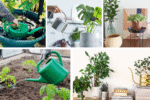Few vegetables are as universally loved and versatile as the humble carrot. These crunchy, sweet, and nutritious roots are a staple in kitchens around the world — and best of all, they’re easy to grow right in your backyard or even in containers on a balcony. If you’ve been thinking about adding carrots to your homegrown garden harvest, you’re in the right place.
In this detailed guide, we’ll walk you through how to start growing carrots, from selecting the right varieties to sowing, caring, harvesting, and troubleshooting your way to perfect, crisp roots.

Why Grow Carrots?
There’s something incredibly satisfying about pulling a bright orange (or purple, yellow, or white!) carrot out of the soil. Growing carrots offers several advantages:
- Fresh, chemical-free produce
- Variety choices beyond supermarket options
- Compact, space-saving plant great for small gardens
- Easy to grow from seed
- Nutritious and packed with vitamins A, C, and antioxidants
Plus, homegrown carrots taste noticeably sweeter and more flavorful than store-bought ones.

Popular Carrot Varieties to Try
Before planting, choose a carrot variety suited to your climate, soil, and taste preferences. Carrots come in different sizes, colors, and shapes.
Classic Orange Varieties:
- Nantes: Crisp, sweet, cylindrical; great for beginners.
- Danvers: Tapered roots, good for heavy or shallow soil.
- Chantenay: Short, thick carrots for clay or rocky soils.
Unique Colors:
- Purple Haze: Deep purple skin with orange core.
- Atomic Red: Bright red-orange, loaded with lycopene.
- White Satin: Smooth, pale white roots with a mild flavor.
When to Plant Carrots
Carrots prefer cool to mild temperatures and grow best in spring and fall.
- In mild climates: Sow seeds in early spring and again in late summer for a fall crop.
- In cold climates: Sow 2-3 weeks before the last expected frost.
- In hot climates: Plant in late fall for a winter harvest.
Soil temperature should be at least 50°F (10°C) for seeds to germinate.

How to Start Growing Carrots from Seed
Carrots are always grown from seed as they don’t transplant well due to their long, delicate taproots.
Prepare the Soil
Carrots need loose, sandy, well-draining soil to grow straight and smooth. Avoid rocky or heavy clay soils.
- Remove stones, clumps, and debris.
- Work in organic compost, but avoid fresh manure (can cause forking).
- Aim for a soil pH of 6.0 to 6.8.
Pro tip: Raised beds or deep containers are excellent for carrot-growing.
Sow the Seeds
- Make shallow furrows ¼ inch deep and 12 inches apart.
- Sow seeds thinly — about 1 inch apart.
- Cover lightly with fine soil or compost.
- Water gently to avoid displacing the tiny seeds.
- Keep the soil moist until germination, which can take 10-20 days.
Pro tip: Mix fine sand with your seeds to help distribute them evenly.

Caring for Your Carrot Crop
Carrots need minimal fuss once established but consistent care ensures high-quality, straight, and sweet roots.
Watering
- Keep soil evenly moist, especially during germination.
- Once sprouted, water deeply once or twice a week.
- Avoid overwatering, which can lead to rot.
Thinning
Carrot seedlings grow densely and need thinning to avoid crowded, twisted roots.
- Thin seedlings to 2-3 inches apart once they’re 1-2 inches tall.
- Snip extras with scissors to avoid disturbing neighboring roots.
Mulching
Add a layer of organic mulch (straw, compost, or shredded leaves) to:
- Retain moisture
- Prevent weed growth
- Keep roots cool in warm weather
Fertilizing
Carrots aren’t heavy feeders but benefit from:
- Balanced fertilizer (10-10-10) before planting.
- Avoid high-nitrogen fertilizers, which promote leafy tops at the expense of roots.

Common Pests and Problems
| Problem | Cause | Solution |
|---|---|---|
| Carrot rust fly | Larvae tunnel into roots | Use row covers, rotate crops yearly |
| Aphids and flea beetles | Sap-sucking pests | Blast with water, introduce ladybugs, or use neem oil |
| Forked or deformed roots | Rocky or compacted soil | Improve soil structure, thin properly |
| Poor germination | Dry soil or overcrowding | Keep soil moist, sow thinly |

Companion Planting for Carrots
Companion planting helps improve growth and deter pests.
Good companions:
- Onions, leeks, garlic (repel carrot flies)
- Radishes (break up soil, allowing carrots to grow straighter)
- Lettuce (provides shade for soil in warmer months)
Avoid planting near:
- Dill or fennel (can stunt carrot growth)
Harvesting Carrots
Carrots can be harvested at various stages — baby carrots when young and tender, or full-grown for maximum sweetness.
- Days to maturity: Typically 60-80 days depending on variety.
- Gently loosen soil around the roots.
- Grasp tops and pull straight upward.
- For continuous harvest, pull every other carrot when young and leave the rest to mature.
Pro tip: Carrots become sweeter after a light frost.
Storing and Preserving Carrots
Freshly harvested carrots can be stored:
- In the fridge for 2-4 weeks (remove tops first).
- In a cool, dark place layered with damp sand or sawdust.
- Blanched and frozen for stews and soups.
- Pickled or fermented for longer shelf life.
Growing Carrots in Containers
If you lack garden space, carrots thrive in deep containers.
Container requirements:
- At least 12 inches deep
- Well-draining potting mix
- Sow seeds thinly, cover lightly
- Keep soil consistently moist
Choose shorter varieties like Paris Market or Little Finger for best results in containers.
Final Growing Tips for Success
- Keep soil loose and debris-free to avoid forked carrots.
- Sow in succession every 2-3 weeks for continuous harvest.
- Label your rows — carrot seedlings are slow and easily mistaken for weeds.
- Protect young seedlings from heavy rain and pests with row covers.
- Don’t let soil dry out during germination — carrots can be stubborn starters.
Conclusion
Growing carrots is one of the most rewarding experiences for home gardeners. With their wide range of colors, flavors, and textures, these crunchy roots are both fun to grow and versatile in the kitchen. By following this complete guide on how to start growing carrots, you’ll enjoy crisp, flavorful harvests straight from your garden, whether in beds, raised planters, or balcony containers.
So grab your seeds, prepare your soil, and start growing your own supply of naturally sweet, healthy carrots today!





